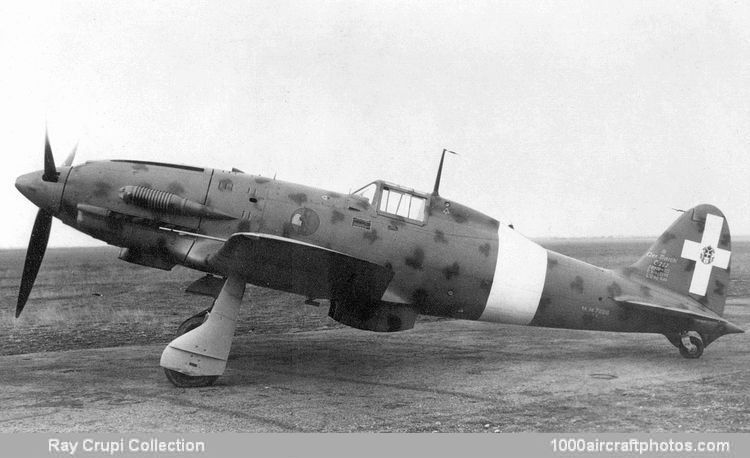The aircraft is wearing the markings of the operating unit it was assigned to, the 73° Squadriglia, 9° Gruppo, 4° Stormo "F Baracca". Count Francesco Baracca (May 9, 1888 - June 19, 1918) was Italy's top fighter ace of WW I, credited with 34 aerial victories."
06/30/2014. Remarks by Johan Visschedijk: "The M.C.202 Folgore (Lightning), which was first employed by the 90 Gruppo of the Regia Aeronautica's 4° Stormo Caccia Terrestre over Sicily in the late summer of 1941, raised Italian fighter design to world standards, being the Regia Aeronautica's first wartime operational interceptor to compare favorably with the first line fighters of the other major combatants.
Retaining the beautiful control co-ordination and superlative maneuverability which had characterized its production predecessor, the M.C.200 Saetta, the M.C.202 Folgore was manufactured in several series by the Macchi factories at Varese-Schiranna and Lonate Pozzolo, and by the Breda and S.A.I.-Ambrosini plants at Sesto S. Giovanni and Passignano, approximately 1,500 fighters of this type being produced during 1941-1943.
The prototype M.C.202 (MM 445) powered by an imported Daimler-Benz DB 601A-1 twelve-cylinder liquid-cooled inverted V-engine flew for the first time on August 10, 1940, and so successful were initial trials that quantity production was commenced immediately by Breda under sub-contract, and by making use of a considerable proportion of the jigs and tooling for the earlier Saetta, the first production deliveries began only some eight months later.
The Folgore's structure was essentially similar to that of the Saetta, the vertical and horizontal tail surfaces and landing gear being identical as were also the wings, apart from the installation of 10.6 gal (40 l) fuel tanks in each of the inboard wing sections to supplement the 70.8 gal (268 l) and 21.2 gal (80 l) fuselage tanks. The fuselage was of improved aerodynamic form. An enclosed cockpit was employed, the Italian fighter pilot's dislike of this development having at last been overcome, and the strengthened canopy frame rendered unnecessary the anti-turn over structure aft of the pilot's head featured by the Saetta.
Initial production Folgore fighters were powered by imported DB 601A-1 engines, but the majority of the fighters of this type manufactured received a license-built version of this engine, the Alfa Romeo R.A.1000 R.C.41-1 Monsonie, driving a Piaggio P.1001 constant-speed airscrew. Early production series fighters had the light built-in armament of two 0.50 in (12.7 mm) Breda-SAFAT machine guns mounted over the engine, but later production series (e.g., Serie IX-XI) also carried a 0.303 in (7.7 mm) Breda-SAFAT machine gun between the seventh and eighth rib of each wing, while one batch carried a 0.787 in (20 mm) Mauser MG 151 cannon under each wing. Late production models featured bullet-proofwind-screens and underwing shackles for two 26.4 or 39.6 gal (100 or 150 l) drop tanks or 110, 220 or 330 lb (50, 100 or 150 kg) bombs.
The first M.C.202 Folgore fighters reached Libya on November 25, 1941, these belonging to the 10 Stormo Caccia Terrestre. The similarly-equipped 40 Stormo arrived in the Western Desert in the following May, and the Folgore rapidly established an ascendancy over the opposing Hawker Hurricane and Curtiss P-40 fighters. Early in September 1942, the first Folgores were delivered to the 210 Gruppo fighting over Russia where they served until May of the following year.
The Folgore was the most successful Italian fighter to see extensive wartime service, but inadequate production of the DB 601A-1 engine by Italian factories (which had to be shared with the Re.2001 and rarely exceeded fifty units per month) and strict limitations on the deliveries of surplus engines from Germany necessitated the retention of the obsolete M.C.200 Saetta in parallel production, shortage of power plants preventing a complete change-over of the production lines to the superior fighter. The parent company completed 392 Folgores."
The following data relate to the late production Serie IX-XI Folgore.
